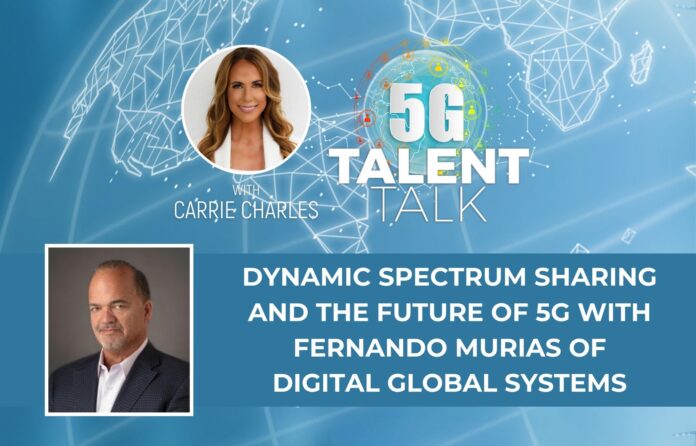Innovative solutions are shaping the future of connectivity, and today’s featured company tackles things like enhancing RF awareness and tackling challenges in private wireless optimization and dynamic spectrum sharing. In this episode of 5G Talent Talk, host Carrie Charles sits down with the visionary Fernando Murias, Chairman and CEO of Digital Global Systems. Fernando takes us on a captivating journey through his 30+ years of experience in high-tech telecom and government contracting, sharing valuable insights into the evolution of wireless communications. Discover how DGS, under Fernando’s leadership, has become a trailblazer in developing technology critical for the rollout of 5G. Don’t miss the opportunity to gain firsthand knowledge from a leader at the forefront of driving positive change in the industry.
—
Watch the episode here
Listen to the podcast here
Dynamic Spectrum Sharing and the Future of 5G with Fernando Murias of Digital Global Systems
Thanks for joining me today on 5G Talent Talk. I’m Carrie Charles, your host, and I’m really excited about the guest I have today. This is Fernando Murias. He is the Chairman and CEO of Digital Global Systems. Fernando, thank you for joining me today.
It’s an honor, thanks for having me.
So, Fernando, I’d love to hear your journey, and how you got to the seat that you’re in today.
It’s been an interesting journey. Actually, I spent 30 plus years with PricewaterhouseCoopers. A lot of my focus as a consultant was in the high tech telecom industry government contracting industry. And so I had a very good feel, Carrie, that from an architecture standpoint, the growth in wireless was not gonna be able to be supported by the existing infrastructure that was out there given my consulting in the area with various carriers, and when I was approached by someone who was looking to raise capital for a potential new venture to enhance wireless communications, it really caught my attention.
And so I retired early from PwC, and agreed to join the company as the CEO 11 years ago, and initially started by forming the strategy around what markets we wanted to look at as well as obviously raising capital like you do in a startup. And we’ve been in R&D mode for the last 10 years, really focusing on developing the technology that we thought was going to be needed for the rollout of 5G and the new elements of tech that were coming in this particular space to enable broader communications. And it’s been a wild journey since then. And here we are.
So I want to know more about Digital Global Systems. But we’re going to abbreviate that to DGS. And I think that’s fine with you, right? Okay, so tell us the DGS story.
So we embark, as I alluded to earlier, to develop a technology platform that would enable more efficient communications, more automated ways of identifying interference to making network communications, more effective. Starting with the automated interference. We initially started working with a large carrier who couldn’t identify trouble spots in 15 different areas around the country. And our technology identified the issues in less than 2 hours. So that gave us a lot of confidence to continue the development path on where we were headed. Since then we’ve developed technology that’s yielded 157 patents, and we’ve got 40 patents pending in the US. And quite a large portfolio around spectrum management second only to Qualcomm right now. So we’re very pleased with what we’ve been able to accomplish. But our whole focus as an entity is to really understand the RF environment in real time to provide actionable data to particular customers.
That’s impressive. So, how does DGS enable 5G Performance?
So from a 5G perspective, one of the keys that you need to keep front of mind is that low latency and high reliability are kind of at the cornerstone of the services that are expected to to roll out both with 5G and 6G. And because of our ability to assess the RF Environment in real time and provide actual information, to be able to articulate to someone in this particular market a service that requires low latency will work effectively if you use these parameters that this carrier, etc., we can provide the signal characteristics necessary to tell service providers whether or not the environment is suitable for what they need, whether it’s again low latency, high reliability, whatever the services are going to require.
So I wanna talk about private wireless quickly. How do you believe private wireless should be optimized in order to scale quickly?
Yeah. So if you think about private wireless really growing from the delays that came with 5G rolling out for different reasons, one of the problems or challenges that that private wireless faces today is that in order to allocate spectrum, the CBRS platform uses a static propagation model. And it doesn’t really give the ability for the users to identify a problem. And the spectrum that’s been allocated, whether it’s clear of interference, etc. And as a result of that, as more users come onto a private wireless platform you can expect that the interference is going to be more significant and the allocation spectrum is gonna need to be more dynamic, to be effective. And under the static propagation models that are currently in use, we see the ineffective allocation of spectrum by not having real time RF Information of what’s really happening in the environment as an impediment to scaling that market. As more users come on, it’s gonna become less effective and less optimal as a network, and therefore slow down the growth. If that allocation of spectrum process is improved, which is where we come in, we think that’ll help the growth of that whole platform.

So the new digital economy is providing a number of new services. What role do you see that RAN plays in this? And how does open architecture RAN enable these types of services and changes.
Yeah, now, that’s a great question. So the RAN currently is focused on capacity. I mean, that’s its main goal. The RAN of the future, the next gen. RAN, as we call it, for the new digital economy is really going to be focused more on services, delivering services. In order to do that. you have to have an understanding of what’s happening in the RF environment in real time, in an automated fashion and having accelerated chipsets in the ran that can have software like ours in it to provide the data that’s needed around what’s happening in the RF environment in real time is gonna be critical to roll out 5G services and beyond and and that actually is best done through the RAM. In the past, the parties that controlled the radio access network did not really want to make changes to their radio. And it became difficult for things like, we’re talking about putting new software in that enables these types of functionality, the ORAN architecture, the open architecture is really the gateway to enable changes like this effectively, to be rolled out into the existing infrastructure in the market. So I believe the ORAN initiative is really critical for new technology like ours to be embedded into RAN infrastructure.
The next gen RAN for the new digital economy is really going to be focused more on delivering services.
There’s been a great deal of discussion around spectrum sharing especially lately. What is your view on this topic? And how does DGS support this initiative?
So spectrum sharing, I think, is a critical element. Given that spectrum is finite, it’s fixed. We’re already really crowded in communication. The communication is a sweet spot of the spectrum and the cost for the Government to vacate spectrum has become significant and almost unattainable right? And so sharing spectrum frees up a significant amount of additional spectrum that the Government could repurpose, if it doesn’t have to vacate. And the perfect example of that is the spectrum that’s being talked about for 5G services right now the 3.1 to 3.45 gigahertz for the upcoming option and for 5G services, and that’s where all the radar and for the US is basically operating now to vacate that space would cost tri trillions of dollars for the the Department of Defense. It’d be just too costly. Sharing that spectrum is a great solution. The people that were concerned about this said that spectrum sharing is a great way to go, but the technology will take 7 years to build, and it’s very difficult to implement in the near term. I agree it’ll take 7 years to build. It took us 7 years to build it, but we started 7 years ago. So we have it. It’s doable. We’ve demonstrated the capabilities of spectrum sharing, dynamic spectrum sharing. And so to be able to have a process to effectively share spectrum prioritize signals which is critical when you’re dealing with the DoD is, I think, a cornerstone of the future, and I was happy to see that in the announcement that came out recently from the Government.
Yes, and tell us more about your view on that. The recent White House announcement that dynamic spectrum sharing be part of the National Spectrum Strategy going forward.
Yeah, we were expecting that. And we were very pleased to see it in writing, finally. Pillar 3 of the announcements specifically talked about innovation and technology in this space and dynamic spectrum sharing has been recognized finally by the Government as a critical way to move forward with the challenge that we have around sharing spectrum around allocating spectrum and dealing with the demand that outweighs the spectrum that’s currently available. So we were very happy to see it. We’re pleased that we have a solution for that, that’s covered by a pretty strong patent portfolio. So you know, we’re very encouraged by it. And we foresaw this coming years ago, which is why we embarked on building this solution. So we’re very pleased about it.
So you mentioned the DoD. How is spectrum utilized in the military?
So one of the things that I found really interesting was recent announcements that if you look at the domains that the DoD operates in air land, sea, and then space, and then, recently announcing spectrum as the fifth domain of the warfighter was really important. When you look at the DoD, not just coordination of communication on the battlefield, but also to be able to use spectrum offensively. In a wartime situation, spectrum as a weapon, if you would, by providing this information to our adversaries has become critically important. From a 5G perspective, the DoDs lagging a lip behind commercial and the use of 5G. We do see it coming. It’s gonna be important for them. On communications and automating security systems that they have. But using spectrum and RF intelligence is critically important. So from that perspective, you know what we call RF awareness to improve the situational awareness of the warfighter is really important.
So give us a glimpse into the future. What’s on the horizon for DGS?
So we will continue our development efforts. We see the processing of signal data at the edge in an automated fashion as critical to the continued growth, and to meet the demands of spectrum and all the services that we see coming. We believe ground sensors are critical to have the information that’s needed from a signal characteristic standpoint. to be able to drive some of the things I spoke about earlier when we’re talking about low latency, high reliability, spectrum sharing, etc. But we believe the disbursement of the sensors to enable that will move from devices placed on rooftops and towers to chipsets inside the RAM to really scale the ability for this software to be very pervasive and get out into the market quickly, and then ultimately for every cell phone to become a sensor, to have the software and the technology embedded in the chips that can enable every device to become a sensor to provide information on the RF environment. So we see a future where automated RF intelligence at the edge is going to continue to be critical. And that’s where we’re heading and continuing with our development efforts.
Exciting times ahead and sounds like DGS is leading the charge there. So congratulations.
Thank you, Carrie.
Fernando, this has been insightful. I’ve learned a lot from you, and just the few times that I’ve spoken to you. How can we reach DGS?
So our website is, I wish it was DGS and not Digital Global Systems. But it’s www.digitalglobalsystems.com. That’ll take you to the website, and it has information on what our priorities are as a company. I always struggle to try to articulate what we do in a 30 second elevator speech. But when you look at our website, we really kind of break out the 4 pillars of what we think our technology enables. And that’s facilitating new 5G services, which we’ve talked about here on this podcast, enhancing the next generation RAN, which we’ve also talked about, improving private wireless performance. And then, fourth, basically enabling dynamic spectrum sharing. So we covered all 4 of those pillars, which is what you’ll see on our website. That’s our focus. That’s our technology. And then obviously, how to reach us as well.
Fernando, Thank you so much for coming on the show. It’s been a pleasure.
Thank you, Carrie. Thanks for having me.
Yes, take care.
Thank you.
Important Links
- Digital Global Systems
- LinkedIn – Fernando Murias
About Fernando Murias
 Fernando Murias is the Chairman & CEO of Digital Global Systems (DGS), a signals analysis company he joined in 2013. With over 32 years in public accounting, including as a partner at PricewaterhouseCoopers (PwC), Fernando led the growth of various businesses, raising approximately $100M in capital for DGS to fund the development of 157 issued US patents valued at in excess of $1B. Fernando’s leadership at PwC included roles like Managing Partner of the Greater Washington Region, where the practice became one of PwC’s largest in the US.
Fernando Murias is the Chairman & CEO of Digital Global Systems (DGS), a signals analysis company he joined in 2013. With over 32 years in public accounting, including as a partner at PricewaterhouseCoopers (PwC), Fernando led the growth of various businesses, raising approximately $100M in capital for DGS to fund the development of 157 issued US patents valued at in excess of $1B. Fernando’s leadership at PwC included roles like Managing Partner of the Greater Washington Region, where the practice became one of PwC’s largest in the US.
A growth-oriented CEO, he built the Washington Federal practice to $400M post-sale to IBM. Fernando is recognized for civic leadership, having chaired over 15 civic and business organizations receiving awards for fundraising efforts. Currently, he is the Chairman of the Board of Charity Works and founder of the Greater Washington Sports Alliance. Fernando graduated Magna Cum Laude from the University of Maryland.
Love the show? Subscribe, rate, review, and share!
Join the 5G Talent Talk Community today:

